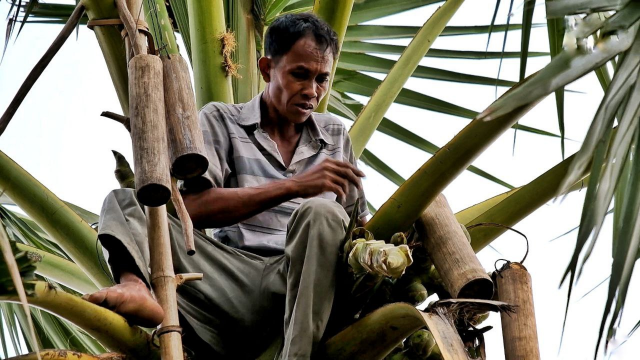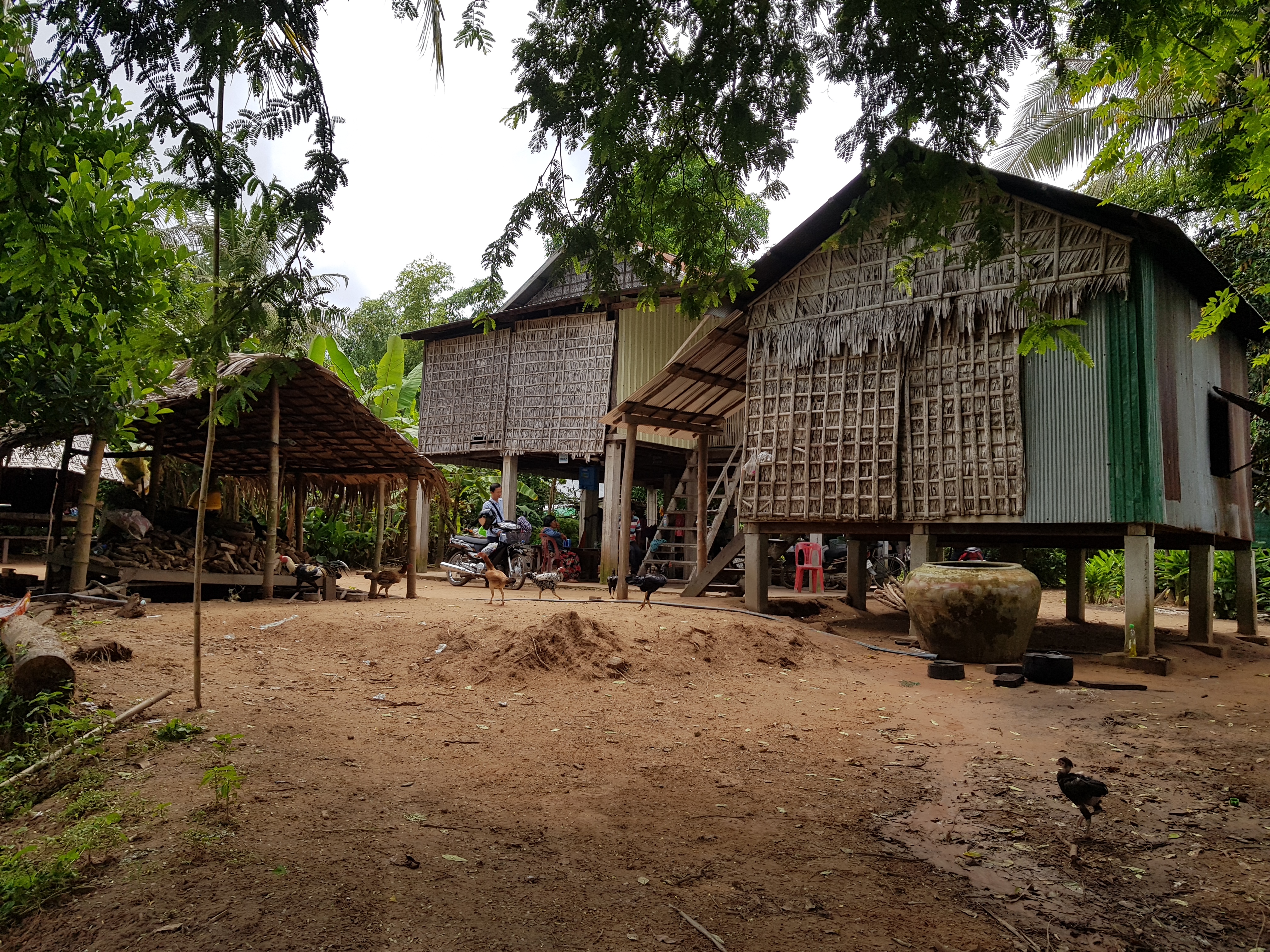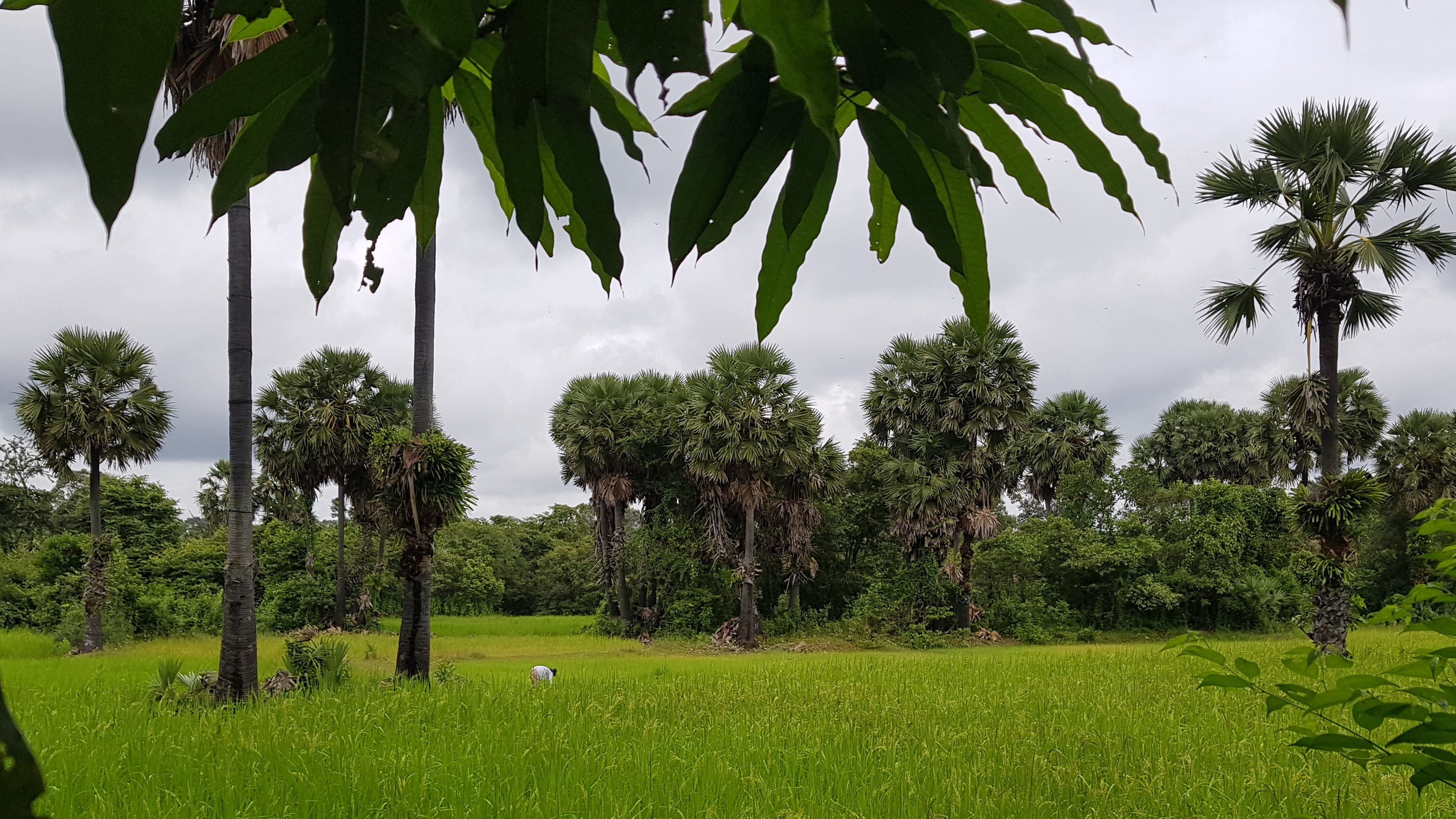Drop by Drop, the Bottle Is Filled: How People Make Sugar from Palm-Tree Sap?

- By Long Ton
- January 15, 2023 7:30 PM
SIEM REAP - In Cambodia, palm sugar is considered an important ingredient in every household’s kitchen. With its soft taste, pleasant aroma and health benefits, palm sugar is frequently used in everyday cooking as well as for coffee making. When comparing it to conventional white sugar, for many Cambodians, palm sugar is better. And so special that since 2019, the Kampong Speu Palm Sugar, or Skor Thnot Kampong Speu in Khmer, has held Geographical Indication (GI) status in the European Union.
With a large number of palm trees growing all over the land, and especially in the countryside and rice paddies, harvesting palm-tree sap is still common practice in many Cambodian villages.
_1673751456.png)
In addition to its sap being turned into palm sugar, every element of the palm tree, which is Cambodia’s national tree, is put to use. Its leaves serve to make traditional houses’ roofs or walls as well as hats. Its trunk can be used to make small boats, house pillars, small chairs and day-to-day equipment such as plates, cups or brooms. Its branches can be turned into decorations. Finally, of course, its sweet sap can be used in many ways whether in soups or desserts including cakes as well as made into wine and vinegar. Palm trees are a prominent element of Cambodia’s landscape and frequently features in paintings and drawings depicting the country.

Palm sugar tends to be produced from November through the end of June. In Siem Reap province, Mek Lo is one of the older people of Ta Kos village in Banteay Srey district’s Preah Dak commune who make palm sugar for a living.
_1673751959.png)
Mek Lo: Usually, we would start preparing to collect the palm juice at the start of November even though the juice is then in small amount. By December, the juice will have increased. And from January through February the juice will be plentiful in quantity.
Long Ton: The start of the process is in November, and when does the period end?
Mek Lo: We start collecting the juice in November and stop whenever there is no more juice to be collected. Typically, as the rainy season arrives around June, the amount of juice will decrease…And when it rains, the strong wind makes it difficult to climb palm trees.
_1673752038.png)
Palm juice is sweet as it drops slowly from the palm flowers. The flower can be either female or male. Distinguished by their appearance, the male flowers are longer whereas the female ones have round lumps on them. The female flowers will eventually transform into fruits if they last long enough.
To obtain those precious droplets from the flower, one must climb to the top of the palm tree using those…rudimental bamboo stairs to apply pressure on the flowers so that the juice can flow out. The squeezing technique can be different from place to place. But Mek Lo who has worked in the field for more than two decades has his own way of extracting the liquid.
First, he will look at the flowers to determine which ones are ready to be compressed. Then he compresses a flower during four to seven days. The tools to do this are simple devices specifically designed for each type of flower. The stick used for the female flower is round and long while the one for the male flower has a flat surface at the end of the stick.
_1673752169.png)
There usually are three flowers per stem for the male flowers, the middle one having to be discarded. In the case of female flowers, Mek Lo with compress them for a certain time and then cut the lumps and one end of the flowers. After they have been compressed, all the flowers are soaked in water for one day and then dried in the sun for one day. This done, he will slice the end of each flower one to three times to get the juice into bamboo bottles.
Mek Lo will repeat this process over and over, climbing the trees to make cuts on flowers and to change the bottles twice a day.
Long Ton: Do you harvest both female and male flowers at the same time?
Mek Lo: I harvest the male ones first because they bloom first.
Long Ton: How many days does it take you to compress the palm fruit to get its juice?
Mek Lo: Typically, it takes around five to seven days, but it depends on the fruits as well. For example, if the fruit is quite soft, it will take around four days while longer periods are needed for harder ones. And the flowers of both will take up to two days of being submerged in water. The number of days goes up if the flowers are bigger, sometimes up to three days. Then, the flowers go through the process of sun-drying before their ends are cut to collect the precious juice. The juice goes up about two centimeters [inside the cylindrical bamboo container] per night and this will gradually increase in the course of the days. Usually on the seventh night, the content will reach half of the bottle. In some cases, the juice will stop at half the bottle. But it depends on the weather as well. If the weather is cool, then the quantity of juice will be high. If it is about to rain, then the amount of juice will decrease or stop flowing.

Important point: The bamboo containers must be sanitized. If they are not cleaned thoroughly, the juice will spoil easily. After the juice has been poured into the cooking pot for heating, the bamboo containers must be thoroughly washed and dried before being rinsed a last time in hot water. In some parts of the country, people will burn palm leaves and then press them in the bottles to preserve the scent of palm. This technique will release a pleasant smell while at the same time sanitizing the bottles.
_1673752552.png)
Long Ton: What is the concept behind cleaning the bamboo bottles?
Mek Lo: A clean container will prevent the juice from spoiling. If there is leftover in the container, the freshly squeezed pollen will quickly spoil. If the container is cleaned, no matter whether the weather changes or what is the consistency of the juice, it will keep the pollen in good condition.
In palm sugar production, one of the most important ingredients is the “propel” tree [or shorea roxburghii]. This tree that has somehow a bitter taste is important because it will turn palm juice into a sweet and tasty drink. If pieces of that tree are not added, the juice will turn murky and slimy as soon as it gets into the bamboo bottles. Therefore, one or two small pieces of propel will be put at the bottom of the containers to avoid that from happening. Propel is commonly used as part of the process and, because its use is so widespread, people are constantly worried that it will run out one day.
Long Ton: Why do you need propel to be put in?
Mek Lo: Propel is necessary because it keeps the juice from going bad. [Used in traditional medicine, this tree’s bark has high antioxidant power.] Because of its bitterness, the juice will turn sweet and clear.
The pot that is used to boil palm juice is called by several names. Depending on the region of the country, it may be called either kok skor or pong skor. It takes two to three hours for the water in the palm juice to evaporate when boiling the juice. The quantity and quality of palm sugar produced are highly dependent on the weather and the conditions of the soil and trees.
Long Ton: So, it takes about 8 to 12 liters of palm juice to make one kilogram of sugar, is that correct?
Mek Lo: Actually, to make one kilogram of sugar may require as much as eight to nine liters of palm juice.
The length of the flowers can alter the quantity of juice being collected. For example, the lower part of the flower to the mid-section will make 8 to 12 liters of juice while the mid-section to the top of the flower will make about 8 to 10 liters.
Throughout the boiling process, the temperature in the pot must be maintained and watched. It must not be too hot not to cause the sugar to burn. Therefore, the heat level and color must be carefully monitored.
_1673752794.png)
As it boils, the juice must be stirred, and the tool used to do so varies according to people’s preferences. Some may use a single rod, others one with a supporting leg. Whether one is making dry, powdery or liquid palm sugar, stirring cannot be overlooked because it will intensify the quality of the palm sugar, making its color fairer, accentuating its sweet aroma, and getting its natural granulated texture to appear. After the heating process, the sugar will be left to chill and also stirred to avoid the sugar from acquiring a red dark color. Then, the process of transferring the sugar into a mold must be done quickly as the sugar hardens within two to three minutes.
_1673752893.png)
In Cambodia, molded or hardened palm sugar can be kept at room temperature as it will not melt. As for the liquid palm sugar, it can be kept for up to one year. If you happen to see tiny round particles at the bottom of the container and watery substances on top of the liquid palm sugar, this indicates that the palm sugar is of good quality.
Long Ton: Between the liquid and hardened palm sugar, which one keeps longer?
Mek Lo: The liquid lasts longer.
Long Ton: What about palm sugar with grains?
Mek Lo: Grains in palm sugar occasionally happen when the heat is not high enough. As a result, grains will occur, but it indicates that the liquid or hardened palm sugar is of good quality and can be kept longer.
Long Ton: What about powdered palm sugar? Does it mean that people must stir for the liquid to evaporate even more?
Mek Lo: The stirring process is the same for every form of sugar. But there are two kinds of powdered palm sugar. The first type requires to boil the palm juice at higher temperature. The second type has a reddened liquid on its upper layer and grains at the bottom.
Long Ton: Can we say that, if we see grains at the bottom and red liquid above, this is high-quality sugar?
Mek Lo: Yes.
Long Ton: How long can one keep it?
Mek Lo: Typically, it can be kept for more than one year. But the habit is to only keep it one year.
Long Ton: For more than 20 years, you have been climbing palm trees and making palm sugar for a living. Has it been exhausting for you? Have you ever thought of no longer doing this work?
Mek Lo: No, I have not because I have been doing this for so long now. I stopped once and went on to sell charcoal. But it did not work, and so I went back to making palm sugar. I will continue climbing palm trees and making sugar as long as I have the energy to do so. I have been doing this since I was 20 years old and now, I am 50.
Long Ton: What about your children? Are they willing to continue this business?
Mek Lo: No because among them, only one dares climb palm trees. The younger ones are scared.
Long Ton: Do you think they are hesitant to continue this job because they are scared, or they are unwilling because of the income?
Mek Lo: Most likely, it is because of the height factor: It is frightening sometimes.
_1673753033.png)
Long Ton: Based on your experience and perspective, do you think that this profession provides a comfortable living?
Mek Lo: Yes, it does. I am able to feed my family, have my children complete their education, and cover other living expenses. This amount of income is sufficient for daily living.
Long Ton: Therefore, for you, this profession can provide comfort for your family.
Mek Lo: However, I must say that this work is extremely exhausting. If you have a team of five people, all five people will be equally tired. Because there is a lot to do like cleaning the bamboo bottles, caramelizing, stirring. Therefore, it requires a well-synchronized and hardworking team.
Originally written in Khmer for ThmeyThmey25, this story was translated by Song Daphea for Cambodianess.















